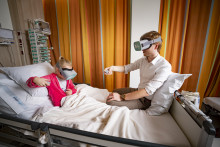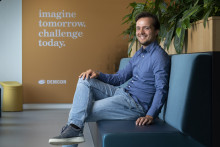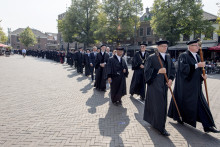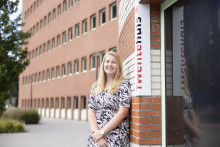It is a busy day at the Intensive Care department of the Wilhelmina Children's Hospital. Nurses are rushing to and fro, families sit with the young patients. In one of the big hospital beds lies a young boy of around four years old. He looks up when the VR goggles are brought into the room. ‘Would you like to try them out?’ The boy nods his head excitedly. The large goggles are strapped onto his head. While his nurse busies herself with injections and tubes, the young patient leaves for a virtual world. ‘What do you see?’ A brief silence. ‘I see a ball, a bridge and a river. And I see a slide. I want to go there!’
Playground
Jason van Eunen watches with a satisfied look on his face. Together with Freek Teunen, Koen Vogel and Emiel Peperkamp, he came up with and developed PlaygroundVR, a virtual playground for sick children. Since November, it is being tested in the Wilhelmina Children's Hospital in Utrecht. ‘What we offer is a playground for children who cannot go outside themselves. It is a virtual world in which they can play together and forget about their illness and their treatment for a while.’
Van Eunen explains they had their idea some four years ago. ‘Three of the four people behind PlaygroundVR study or studied Creative Technology at the UT. We all love virtual reality. We asked ourselves where VR can have the biggest impact. Anywhere you don't really want to be, right? Imagine what a child stuck in a hospital bed feels like. They want to play outside, and PlaygroundVR allows them to experience this without even having to get up.’
'Imagine what a child stuck in a hospital bed feels like'
‘We developed this virtual world ourselves from scratch, both the design and the code. We try to make everything as accessible as possible in our world. The game is easy to control. There is no starting point or game-over screen. After all, a real playground doesn't have that either.’
Playing together
The Wilhelmina Children's Hospital is the first place where PlaygroundVR is being used and tested. Pedagogical staff member Martin Beuzel is excited about the VR goggles. ‘It can distract children while they are getting an injection. As two doctors work on them, the child has lost itself in the virtual playground. The children truly believe they are in a completely different world. They can also play with other children or their families as equals. A child that does not have the strength to throw a ball in real life experiences no such limitations in virtual reality, which is essential to a child's development.’
Bringing children together is one of the main goals of PlaygroundVR, Van Eunen explains. ‘The multiplayer functionality allows children to play together in the virtual world. That means a child in ward A can meet a child from ward B in the virtual playground. This leads to new friendships. They can come up with games together, like sword fighting or hide and seek. Once they get better, they can play those same games in the real world. How awesome is that?’

Jason van Eunen (on the right) shows the VR goggles to a young patient
Future
Van Eunen emphasises that the project is still in its pilot phase. ‘At first, we visited hospitals at our own initiative. It is tough to get involved in the hospital market. A lengthy decision-making process has to be completed before anything can be implemented. Patient care always comes first – and so it should, of course.’
Crowdfunding allows the creators of PlaygroundVR to ‘donate’ the virtual playground to a number of hospitals, Van Eunen explains. ‘The hospitals do not have to pay a penny. To achieve that, we have set up a crowdfunding promotion. Our goal is to raise €18,000 with it. That will allow us to offer the technology to a hospital for free. Our ultimate goal would be to have a little room near the entrance of every hospital where children can pick up their goggles.’
Hide and seek
Back to the Intensive Care – or rather, back to the virtual playground. The young boy has walked over to the slide. Once at the top, he unfortunately discovers it is closed off by some virtual tape. Unlike in a real playground, you cannot simply crawl underneath it in VR. Van Eunen: ‘We have not finished developing the slide yet. Perhaps it will be ready in the next version.’
The young patient's mother has been given a pair of VR goggles of her own. ‘I can't see you! Where are you?’ Chuckling. ‘I'm not telling, come find me.’ They are playing a virtual game of hide and seek, which works just as well in the virtual world as it does in the real world. Then again. The boy takes his goggles off. ‘You can see me now, right?’







